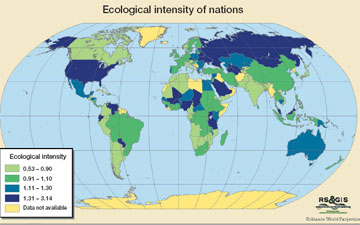Consumption, population drive environmental problems, not urbanization or life expectancy finds study
Human ecological footprint to grow 34% by 2015 finds study
Consumption, population drive environmental problems,
not urbanization or life expectancy
Rhett A. Butler, mongabay.com
February 8, 2007
Population size and affluence are driving environmental degradation according to a new study published in the current edition of the journal Frontiers in Ecology. The authors say other that widely cited drivers of environmental stress — urbanization, economic structure, age distribution — actually have relatively little impact. They also found that “increased education and life expectancy do not increase environmental stressors, suggesting that some aspects of human well-being can be improved with minimal environmental impact.”
Creating a statistical modeling program known as STIRPAT, Eugene A. Rosa of Washington State University, Richard York of the University of Oregon, and Thomas Dietz of Michigan State University, systematically and empirically assessed anthropogenic factors that drive adverse environmental impacts. The researchers projected the ‘ecological footprint’ for the year 2015 for all countries that currently have at least one million people. The ‘ecological footprint’ is “a quantitative measurement of the stress placed on the environment by demands for available lands and resources to meet the need for food, housing, transportation, consumer goods and services,” explained a Washington State University news release written by Robert Strenge.
 Ecological intensity is a measure of how much impact a nation has, net of other drivers. It is an impact multiplier, with a value of 1 indicating that a nation is at global average intensity, a number less than one indicating below average intensity, and a number greater than one indicating greater than average intensity. Image and caption text courtesy of Frontiers in Ecology. |
The researchers found that “increases in population and affluence will likely expand human impact on the environment by over one-third.” In order to mitigate this impact, countries would need to increase their efficiency of resource use of about 2% per year. Most of the environmental impact will result from growth of consumption in China and India, the world’s two largest countries.
“China would need to improve its technical efficiency at a rate of about 2.9 percent per year, and India by about 2.2 percent per year to offset the projected growth of their ecological footprints,” they wrote. “The projected increases for China and India are 984 million and 738 million hectares, respectively, or 37% of the total global increase in footprint projected. The evolving environmental policies in these nations will undoubtedly be critical in the move towards global sustainability.”
In contrast, Russia is expected to see a 25% drop in its ecological impact by 2015, according to the authors.
The United States, currently the country with the largest ecological footprint, is expected to have less of an impact, on a relative scale, in 2015.
“The impact of the US alone, while projected to increase less rapidly than that of China or India, constitutes 17.5% of the global environmental impact in 2015, as opposed to just over 20% at present.”
Overall the United States has an the ecological intensity of 1.4, meaning that its ecological footprint is “1.4 times as large as would be
expected based on its population size, level of affluence, land area, and latitude alone,” note the authors.
Globally, Rosa, York, and Dietz predict a ecological footprint of about 18.1 billion hectares in 2015, an area 34 percent larger than the current (2001) footprint of 13.5 billion hectares. As it is estimated that Earth has some 11.4 billion productive hectares, the human footprint of 2015 will increase to 1.6 planets. The authors say it is unlikely that technological advancements will be able to offset this growth rate, though they concede that concerted international effort could make it possible, noting that “energy efficiencies of national economies have improved by as much as 5% per year in some cases.”
The authors close on an optimistic note, writing, “it appears to be possible to decouple improvements in human well-being from increases in environmental impact so that, for example, the Millennium Development Goals of the UN might be achieved without increased environmental impact if appropriate strategies are used. ”
Citation:
Dietz, T. et al. (2007). Driving the human ecological footprint. Frontiers in Ecology 2007; 5(1): 13—18
This article used quotes and information from “WSU Researcher Finds Population, Consumption Drive Global Climate Change and Environmental Degradation” by Robert Strenge and “Driving the human ecological footprint” by Thomas Dietz, Eugene A Rosa, and Richard York.